The global industrial vertical washing tower market is valued at USD 850.2 million in 2025. It is slated to reach USD 1,165 million by 2035, recording an absolute increase of USD 314.8 million over the forecast period. This translates into a total growth of 37%, with the market forecast to expand at a compound annual growth rate (CAGR) of 3.2% between 2025 and 2035. The overall market size is expected to grow by approximately 1.37 times during the same period, supported by increasing demand for air pollution control equipment in industrial facilities, growing adoption of vertical washing tower systems for emissions compliance and environmental protection, and rising emphasis on operational efficiency and regulatory compliance across diverse chemical processing, electronics manufacturing, pharmaceutical production, and metal processing applications.
Between 2025 and 2030, the industrial vertical washing tower market is projected to expand from USD 850.2 million to USD 995.2 million, resulting in a value increase of USD 145 million, which represents 46.1% of the total forecast growth for the decade. This phase of development will be shaped by increasing environmental regulations and emissions standards enforcement, rising demand for effective air pollution control systems in chemical and manufacturing facilities, and growing emphasis on workplace safety and environmental sustainability programs. Industrial facility operators and environmental engineering companies are expanding their vertical washing tower capabilities to address the growing demand for reliable and efficient solutions that ensure regulatory compliance and environmental protection.
From 2030 to 2035, the market is forecast to grow from USD 995.2 million to USD 1,165 million, adding another USD 169.8 million, which constitutes 53.9% of the overall ten-year expansion. This period is expected to be characterized by the expansion of advanced scrubbing technologies and smart monitoring systems, the development of energy-efficient designs and modular tower configurations, and the growth of specialized applications for semiconductor manufacturing and pharmaceutical production facilities. The growing adoption of Industry 4.0 integration and predictive maintenance strategies will drive demand for vertical washing towers with enhanced automation and performance optimization features.
Between 2020 and 2025, the industrial vertical washing tower market experienced steady growth, driven by increasing environmental regulations and growing recognition of vertical washing towers as essential equipment for controlling air emissions and protecting environmental quality in diverse industrial and manufacturing applications. The market developed as environmental engineers and facility managers recognized the potential for vertical washing tower technology to remove harmful gases, capture particulate matter, and support compliance objectives while meeting stringent performance requirements. Technological advancement in scrubbing media and tower design began emphasizing the critical importance of maintaining removal efficiency and operational reliability in challenging industrial environments.
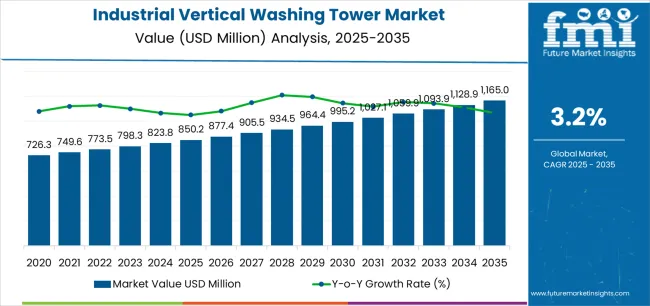
| Metric | Value |
|---|---|
| Estimated Value in (2025E) | USD 850.2 million |
| Forecast Value in (2035F) | USD 1,165.0 million |
| Forecast CAGR (2025 to 2035) | 3.2% |
Market expansion is being supported by the increasing global demand for air pollution control equipment driven by environmental regulations and emission reduction requirements, alongside the corresponding need for specialized scrubbing systems that can enhance air quality, enable regulatory compliance, and maintain operational reliability across various chemical processing, electronics manufacturing, pharmaceutical production, and metal processing applications. Modern facility managers and environmental engineers are increasingly focused on implementing vertical washing tower solutions that can remove harmful pollutants, meet emissions standards, and provide consistent performance in demanding industrial conditions.
The growing emphasis on environmental sustainability and workplace safety is driving demand for vertical washing towers that can support emissions reduction strategies, enable comprehensive air quality management, and ensure worker protection. Equipment manufacturers' preference for scrubbing systems that combine removal efficiency with operational reliability and energy efficiency is creating opportunities for innovative vertical washing tower implementations. The rising influence of circular economy principles and zero-emissions manufacturing is also contributing to increased adoption of vertical washing towers that can provide superior pollutant removal without compromising operational efficiency or environmental performance.
The market is segmented by scrubbing method, application, and region. By scrubbing method, the market is divided into dry scrubbing tower, wet scrubbing tower, and others. Based on application, the market is categorized into chemical industry, electronic manufacturing, medicine, metal processing, food, and others. Regionally, the market is divided into East Asia, Europe, North America, South Asia, Latin America, Middle East & Africa, and Eastern Europe.
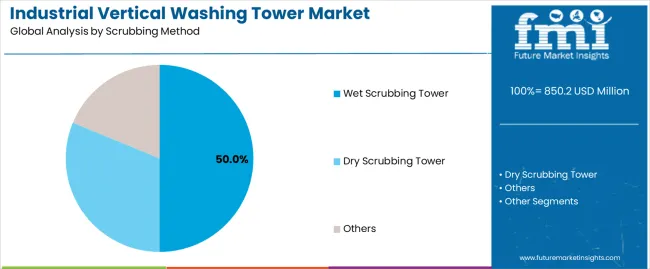
The wet scrubbing tower segment is projected to maintain its leading position in the industrial vertical washing tower market in 2025, reaffirming its role as the preferred scrubbing method for acid gas removal and particulate capture applications. Industrial facility operators and environmental engineers increasingly utilize wet scrubbing towers for their superior removal efficiency, versatile pollutant handling capabilities, and proven effectiveness in treating diverse gas streams while maintaining operational flexibility. Wet scrubbing technology's proven effectiveness and wide application range directly address the industry requirements for comprehensive emissions control and effective air pollution management across diverse industrial platforms and pollutant categories.
This scrubbing method forms the foundation of industrial air pollution control, as it represents the technology with the greatest contribution to removal efficiency and established performance record across multiple industrial applications and pollutant types. Industrial facility investments in environmental compliance technologies continue to strengthen adoption among chemical processors and manufacturing operators. With regulatory pressures requiring stringent emissions control and proven performance, wet scrubbing towers align with both environmental objectives and compliance requirements, making them the central component of comprehensive air quality management strategies.
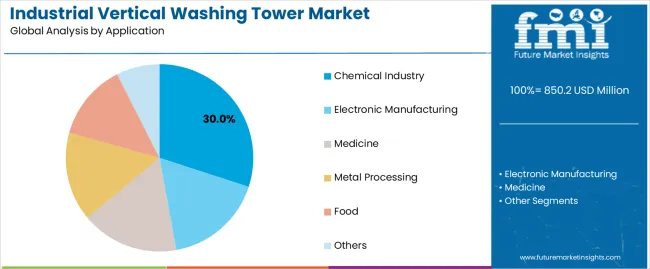
The chemical industry application segment is projected to represent the largest share of industrial vertical washing tower demand in 2025, underscoring its critical role as the primary driver for vertical washing tower adoption across chemical processing facilities, petrochemical plants, and specialty chemical manufacturing operations. Chemical facility operators prefer vertical washing towers for emissions control due to their exceptional removal capabilities, operational reliability benefits, and ability to handle corrosive gases while supporting regulatory compliance and environmental protection objectives. Positioned as essential equipment for modern chemical manufacturing, vertical washing towers offer both environmental advantages and operational benefits.
The segment is supported by continuous innovation in scrubbing technologies and the growing availability of advanced tower designs that enable superior pollutant removal with enhanced corrosion resistance and reduced maintenance requirements. Additionally, environmental equipment manufacturers are investing in comprehensive product development programs to support increasingly stringent emissions regulations and facility requirements for reliable air pollution control solutions. As chemical manufacturing faces increasing regulatory scrutiny and environmental standards tighten, the chemical industry application will continue to dominate the market while supporting advanced scrubbing utilization and facility environmental performance optimization strategies.
The industrial vertical washing tower market is advancing steadily due to increasing demand for air pollution control equipment driven by environmental regulations and growing adoption of emissions reduction practices that require specialized scrubbing systems providing enhanced removal performance and compliance assurance benefits across diverse chemical processing, electronics manufacturing, pharmaceutical production, and metal processing applications. However, the market faces challenges, including high capital investment costs and installation complexity, competition from alternative air pollution control technologies and emissions reduction methods, and operational constraints related to wastewater treatment requirements and energy consumption. Innovation in scrubbing media and tower design technologies continues to influence product development and market expansion patterns.
The growing stringency of environmental regulations is driving demand for advanced air pollution control equipment that addresses emissions compliance challenges including acid gas removal, volatile organic compound control, and particulate matter capture requirements. Modern industrial facilities require sophisticated vertical washing tower solutions that deliver superior removal efficiency across multiple parameters while maintaining operational reliability and cost-effectiveness. Environmental engineering firms are increasingly recognizing the competitive advantages of vertical washing tower integration for regulatory compliance assurance and environmental performance enhancement, creating opportunities for innovative scrubbing systems specifically developed for next-generation emissions control applications.
Modern vertical washing tower manufacturers are incorporating digital monitoring systems and automated control technologies to enhance operational performance, optimize resource consumption, and support comprehensive facility management objectives through real-time performance monitoring and predictive maintenance capabilities. Leading equipment manufacturers are developing sensor-equipped towers with continuous emissions monitoring, implementing automated chemical dosing systems, and advancing control algorithms that improve scrubbing efficiency and operational optimization. These technologies improve operational capabilities while enabling new performance benefits, including energy consumption reduction, maintenance cost optimization, and data-driven facility management. Advanced automation integration also allows operators to support comprehensive environmental compliance objectives and operational excellence beyond traditional manual control systems.
The expansion of sustainability requirements, facility space constraints, and operating cost optimization needs is driving development of energy-efficient vertical washing towers with precisely engineered designs and exceptional space utilization. These advanced systems require specialized engineering with optimized pressure drop characteristics that address energy efficiency requirements, creating premium market segments with differentiated value propositions. Manufacturers are investing in advanced computational fluid dynamics capabilities and pilot testing systems to serve emerging compact installation applications while supporting innovation in industrial facility design and environmental control industries.
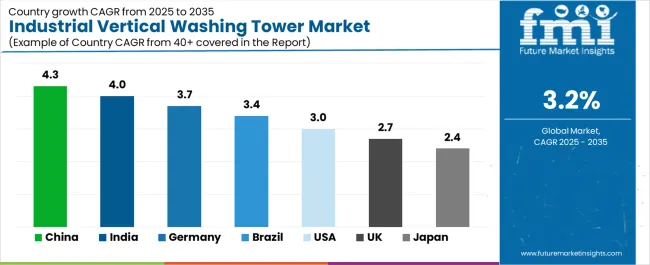
| Country | CAGR (2025-2035) |
|---|---|
| China | 4.3% |
| India | 4% |
| Germany | 3.7% |
| Brazil | 3.4% |
| United States | 3% |
| United Kingdom | 2.7% |
| Japan | 2.4% |
The industrial vertical washing tower market is experiencing solid growth globally, with China leading at a 4.3% CAGR through 2035, driven by expanding industrial manufacturing capacity, strengthening environmental regulations, and increasing adoption of air pollution control equipment in chemical and electronics sectors. India follows at 4%, supported by rapid industrialization, environmental compliance enforcement, and growing investment in emissions control infrastructure. Germany shows growth at 3.7%, emphasizing environmental technology leadership, strict emissions standards, and advanced industrial facility requirements. Brazil demonstrates 3.4% growth, supported by industrial sector expansion, environmental regulation implementation, and growing awareness of air quality management. The United States records 3%, focusing on regulatory compliance requirements, facility modernization programs, and environmental protection standards. The United Kingdom exhibits 2.7% growth, emphasizing emissions reduction targets and industrial environmental compliance. Japan shows 2.4% growth, supported by environmental technology sophistication and stringent air quality standards.
The report covers an in-depth analysis of 20 countries, top-performing countries are highlighted below.
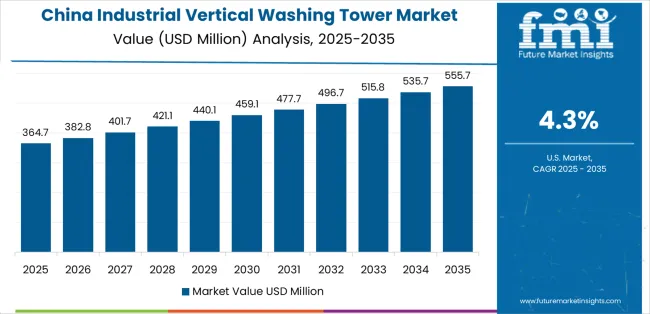
Revenue from industrial vertical washing towers in China is projected to exhibit exceptional growth with a CAGR of 4.3% through 2035, driven by expanding industrial manufacturing capacity and rapidly strengthening environmental regulations supported by government pollution control initiatives and environmental protection policies. The country's massive industrial sector expansion and increasing investment in emissions control technologies are creating substantial demand for vertical washing tower solutions. Major environmental equipment manufacturers and engineering companies are establishing comprehensive production capabilities to serve both domestic markets and export opportunities.
Revenue from industrial vertical washing towers in India is expanding at a CAGR of 4%, supported by the country's rapid industrialization, strengthening environmental compliance enforcement, and increasing demand for effective air pollution control systems driven by regulatory requirements and environmental awareness. The country's comprehensive industrial development and growing environmental consciousness are driving vertical washing tower adoption throughout diverse manufacturing sectors. Leading environmental equipment suppliers and international companies are establishing distribution and engineering service facilities to address growing domestic demand.
Revenue from industrial vertical washing towers in Germany is expanding at a CAGR of 3.7%, supported by the country's leadership in environmental technology, strict emissions standards enforcement, and strong emphasis on advanced air pollution control systems. The nation's environmental engineering excellence and regulatory rigor are driving sophisticated vertical washing tower capabilities throughout industrial sectors. Leading equipment manufacturers and environmental engineering firms are investing extensively in advanced scrubbing technologies and specialized applications.
Revenue from industrial vertical washing towers in Brazil is expanding at a CAGR of 3.4%, supported by the country's industrial sector expansion, environmental regulation implementation, and growing adoption of air pollution control best practices. The nation's comprehensive industrial development and environmental awareness growth are driving demand for effective vertical washing tower solutions. Environmental equipment distributors and engineering service providers are investing in capabilities to serve expanding manufacturing and chemical processing sectors.
Revenue from industrial vertical washing towers in the United States is expanding at a CAGR of 3%, supported by the country's focus on regulatory compliance requirements, established environmental protection standards, and growing emphasis on facility modernization and emissions reduction programs. The nation's comprehensive environmental regulatory framework and industrial infrastructure are driving demand for reliable vertical washing tower solutions. Equipment manufacturers and environmental engineering firms are investing in technology development and service capabilities to serve diverse industrial markets.
Revenue from industrial vertical washing towers in the United Kingdom is expanding at a CAGR of 2.7%, driven by the country's emissions reduction targets, industrial environmental compliance requirements, and growing emphasis on air quality improvement. The nation's environmental policy framework and industrial sector structure are supporting investment in effective air pollution control technologies. Environmental equipment suppliers and engineering consultants are establishing capabilities for equipment specification and compliance support programs.
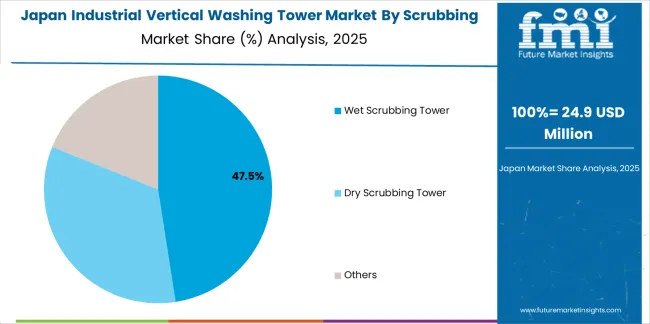
Revenue from industrial vertical washing towers in Japan is expanding at a CAGR of 2.4%, supported by the country's environmental technology sophistication, stringent air quality standards, and strong emphasis on industrial environmental compliance and pollution prevention. Japan's technological excellence and regulatory standards are driving demand for advanced vertical washing tower systems. Equipment manufacturers and environmental engineering firms are investing in specialized technologies suitable for precision manufacturing environments.
How is the European industrial vertical washing tower market split by country?
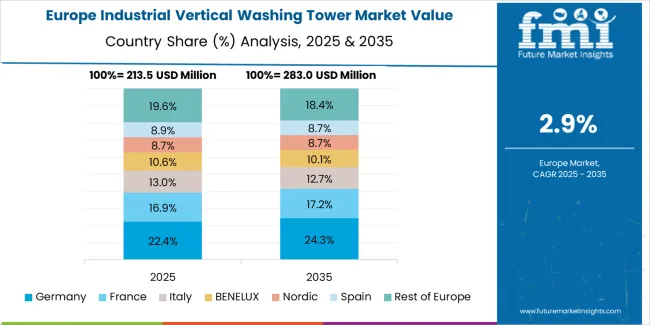
The industrial vertical washing tower market in Europe is projected to grow from USD 317.3 million in 2025 to USD 419.2 million by 2035, registering a CAGR of 2.8% over the forecast period. Germany is expected to maintain leadership with a 31.4% market share in 2025, moderating to 31.1% by 2035, supported by environmental technology excellence, strict emissions regulations, and strong chemical industry presence.
France follows with 19.8% in 2025, projected at 20% by 2035, driven by chemical processing industry, pharmaceutical manufacturing, and environmental compliance requirements. The United Kingdom holds 15.6% in 2025, declining slightly to 15.4% by 2035 due to industrial sector adjustments. Italy commands 11.9% in 2025, rising to 12.1% by 2035, while Spain accounts for 8.4% in 2025, reaching 8.6% by 2035 aided by chemical facilities and industrial environmental compliance. Netherlands maintains 6.2% in 2025, up to 6.4% by 2035 due to chemical cluster activities and port industrial operations. The Rest of Europe region, including Nordic countries, Belgium, Switzerland, and other markets, is anticipated to hold 6.7% in 2025 and 6.4% by 2035, reflecting steady development in industrial emissions control, pharmaceutical manufacturing, and environmental technology adoption.
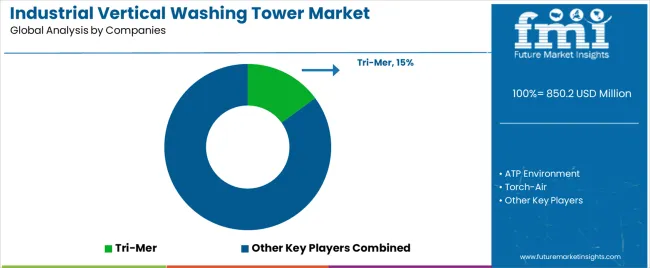
The industrial vertical washing tower market is characterized by competition among established environmental equipment manufacturers, air pollution control specialists, and industrial engineering companies. Companies are investing in scrubbing technology development, energy efficiency enhancement, product range expansion, and application-specific design optimization to deliver high-performance, reliable, and cost-effective vertical washing tower solutions. Innovation in tower internals, scrubbing media, and monitoring systems is central to strengthening market position and competitive advantage.
Tri-Mer leads the market with 15% share with comprehensive air pollution control solutions with a focus on industrial applications, custom-engineered designs, and proven performance across diverse chemical processing and manufacturing applications. ATP Environment provides innovative scrubbing systems with emphasis on energy efficiency and operational optimization. Torch-Air delivers reliable vertical washing towers with focus on chemical industry applications and corrosion-resistant construction. Biodesulf offers specialized systems with emphasis on sulfur compound removal and odor control. Mion Ventoltermica Depurazioni provides comprehensive air treatment solutions with advanced scrubbing technologies. Ravebo specializes in custom-engineered washing towers for chemical and pharmaceutical applications. ECS Industrial focuses on industrial air pollution control equipment. Kimre offers mist elimination and mass transfer solutions for scrubbing applications. Brofind provides environmental control systems with specialized scrubbing capabilities. Schutte & Koerting delivers ejector and scrubbing systems for industrial applications. Airgard specializes in air pollution control equipment. Pollution Systems offers comprehensive environmental solutions. Camplas Technology provides scrubbing systems for diverse applications. Jardar Systems focuses on industrial exhaust treatment. Monroe Environmental delivers engineered air pollution control solutions. LDX Solutions offers custom scrubbing systems. Armatec Environmental specializes in environmental equipment. Verantis provides air treatment technologies. Seikow Chemical focuses on scrubbing solutions for chemical processing.
Industrial vertical washing towers represent a specialized environmental control equipment segment within industrial and manufacturing applications, projected to grow from USD 850.2 million in 2025 to USD 1,165 million by 2035 at a 3.2% CAGR. These air pollution control systems primarily serve emissions treatment requirements in chemical processing facilities, electronics manufacturing plants, pharmaceutical production sites, and metal processing operations where effective pollutant removal, regulatory compliance, and environmental protection are essential. Market expansion is driven by increasing environmental regulations, growing industrial emissions control requirements, expanding manufacturing capacity in regulated industries, and rising demand for reliable air pollution control solutions across diverse industrial sectors.
How Industrial Regulators Could Strengthen Emissions Standards and Environmental Protection?
How Industry Associations Could Advance Technical Standards and Best Practices?
How Vertical Washing Tower Manufacturers Could Drive Innovation and Market Leadership?
How End-User Industries Could Optimize Emissions Control and Environmental Performance?
How Research Institutions Could Enable Technology Advancement?
How Investors and Financial Enablers Could Support Market Growth and Innovation?
| Items | Values |
|---|---|
| Quantitative Units (2025) | USD 850.2 million |
| Scrubbing Method | Dry Scrubbing Tower, Wet Scrubbing Tower, Others |
| Application | Chemical Industry, Electronic Manufacturing, Medicine, Metal Processing, Food, Others |
| Regions Covered | East Asia, Europe, North America, South Asia, Latin America, Middle East & Africa, Eastern Europe |
| Countries Covered | China, India, Germany, Brazil, United States, United Kingdom, Japan, and 20 countries |
| Key Companies Profiled | Tri-Mer, ATP Environment, Torch-Air, Biodesulf, Mion Ventoltermica Depurazioni, Ravebo |
| Additional Attributes | Dollar sales by scrubbing method and application category, regional demand trends, competitive landscape, technological advancements in scrubbing media, energy efficiency enhancement, automation integration, and environmental performance optimization |
The global industrial vertical washing tower market is estimated to be valued at USD 850.2 million in 2025.
The market size for the industrial vertical washing tower market is projected to reach USD 1,165.0 million by 2035.
The industrial vertical washing tower market is expected to grow at a 3.2% CAGR between 2025 and 2035.
The key product types in industrial vertical washing tower market are wet scrubbing tower, dry scrubbing tower and others.
In terms of application, chemical industry segment to command 30.0% share in the industrial vertical washing tower market in 2025.






Full Research Suite comprises of:
Market outlook & trends analysis
Interviews & case studies
Strategic recommendations
Vendor profiles & capabilities analysis
5-year forecasts
8 regions and 60+ country-level data splits
Market segment data splits
12 months of continuous data updates
DELIVERED AS:
PDF EXCEL ONLINE
Industrial Electronics Packaging Market Forecast and Outlook 2025 to 2035
Industrial Absorbent Market Forecast and Outlook 2025 to 2035
Industrial Furnace Industry Analysis in Europe Forecast and Outlook 2025 to 2035
Industrial Denox System Market Size and Share Forecast Outlook 2025 to 2035
Industrial Electronic Pressure Switch Market Size and Share Forecast Outlook 2025 to 2035
Industrial WiFi Module Market Size and Share Forecast Outlook 2025 to 2035
Industrial Security System Market Forecast Outlook 2025 to 2035
Industrial Film Market Forecast Outlook 2025 to 2035
Industrial Floor Mat Market Forecast Outlook 2025 to 2035
Industrial Insulation Market Forecast and Outlook 2025 to 2035
Industrial Process Water Coolers Market Forecast and Outlook 2025 to 2035
Industrial Grade Ammonium Hydrogen Fluoride Market Forecast and Outlook 2025 to 2035
Industrial Grade Sodium Bifluoride Market Forecast and Outlook 2025 to 2035
Industrial Evaporative Condenser Market Size and Share Forecast Outlook 2025 to 2035
Industrial Power Supply Market Size and Share Forecast Outlook 2025 to 2035
Industrial Crystallizer Market Size and Share Forecast Outlook 2025 to 2035
Industrial Counterweight Market Size and Share Forecast Outlook 2025 to 2035
Industrial Gas Market Size and Share Forecast Outlook 2025 to 2035
Industrial Furnace Market Size and Share Forecast Outlook 2025 to 2035
Industrial Weighing Equipment Market Size and Share Forecast Outlook 2025 to 2035

Thank you!
You will receive an email from our Business Development Manager. Please be sure to check your SPAM/JUNK folder too.
Chat With
MaRIA